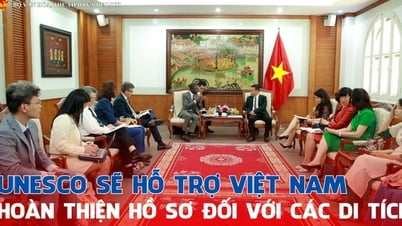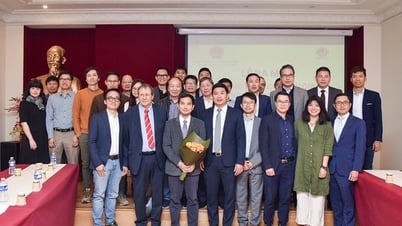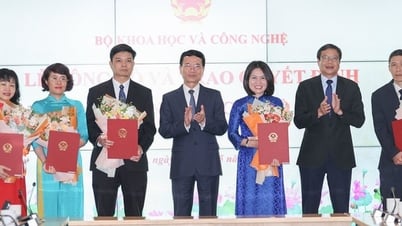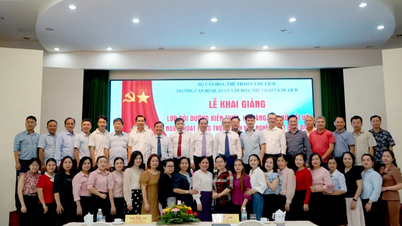Hard to remember - hard to absorb - hard to apply - hard to spread
In recent years, Vietnam has made great strides in promoting financial inclusion, ranking 3rd in the ASEAN region (after Singapore and Thailand), and 14th in the world , in the Global Financial Inclusion Index 2024 by Principal Financial Group. According to the SBV's report, about 87% of adults currently have a payment account, up from 31% in the 2015-2017 period.
With the efforts of the banking sector, the system of organizations providing financial products and services in the market has developed quite diversely, present in most provinces and cities across the country, targeting rural areas, remote areas. The average number of branches and transaction offices of the commercial banking system per 100,000 adults reached 15.69 units; the rate of communes/towns with financial service points out of the total number of communes/towns nationwide reached 32.98%.
 |
| Financialeducation communication has been promoted by the State Bank in recent times. |
Most credit institutions have been implementing digital transformation strategies in their operations; proactively researching and developing digital banking products and services; improving customer convenience and experience by strengthening connections with other industries and sectors, helping people in remote areas access services quickly, safely and conveniently.
Non-cash payment activities have also been continuously expanded with the drastic implementation of many solutions by ministries, branches, localities and relevant agencies. The value of non-cash payment transactions increased by 34.54%; via the Internet channel increased by 33%, via mobile phone channel increased by 34.34%; transactions via QR Code increased by 84.77% compared to the same period in November 2023.
Thanks to that, 5/9 targets set out in the National Comprehensive Financial Strategy are likely to be achieved (including: Proportion of adults with transaction accounts at banks or other licensed organizations; Growth rate of e-commerce transactions; Number of SMEs with outstanding loans at credit institutions; Outstanding credit for agricultural and rural development over total outstanding credit for the economy ; Proportion of adults with credit history information in the State Bank's credit information system.
In particular, for financial education communication, the Ministry of Finance, the Ministry of Information and Communications, and the State Bank of Vietnam have implemented training programs to enhance financial knowledge and skills for people and businesses. The Ministry of Education and Training has integrated financial knowledge into the National General Education Program. Ministries and sectors continue to improve regulations related to the provision of financial products and services towards information transparency, improving the mechanism for resolving customer disputes and complaints to enhance financial consumer protection.
However, the EY Report points out that the process of financial inclusion still faces challenges, including the lack of financial knowledge among a segment of financial service users.
According to banking experts, financial education communication is a solution to provide people and businesses with necessary information and knowledge about banking products and services. Thanks to financial education communication, public awareness of banking products and services will change, thereby confidently accessing and limiting the use of informal banking products and services (black credit). Moreover, each person will have the basic knowledge to better manage personal and family budgets, increase savings resources among the population and promote investment capital for society.
Previously, communication methods were quite simple, only focused on internal banks, lacking interaction with the public. This is the reason for the slow change in people's awareness and behavior in accessing digital banking products and services. In addition, people's access to and use of modern banking and financial products and services is still quite low, especially in agricultural and rural areas due to limited awareness and technological infrastructure.
Turn difficult into easy
Ms. Le Thi Thuy Sen - Editor-in-Chief of Banking Times also pointed out that there are "4 difficulties" that financial education communication activities and promoting e-commerce need to solve. These are: difficulty in remembering (many contents are academic in nature, if the public is not knowledgeable about the field of finance, banking, and e-commerce, they will find it difficult to remember); difficulty in absorbing (information about e-commerce is often difficult to absorb for target groups whose information about finance and banking is limited, especially the public in rural, remote and isolated areas); difficulty in applying (information about e-commerce is often based on documents, lacking in visuality, so the public has difficulty in applying it in practice); difficulty in spreading (traditional communication channels are still one-way and are channels that are unlikely to spread widely among the public).
To thoroughly solve the above 4 difficulties, the "4 easy" solution applied by the State Bank in financial education communication activities is: Easy to understand (simplify technical terms as much as possible so that the public can easily access them); Easy to remember (use creative and flexible forms so that the public can easily remember the message); Easy to do (the processes of accessing and using banking and financial products and services must be guided in the clearest way so that the public can easily apply and follow them in practice); Easy to spread (choose media that have high spread ability among the public).
In recent times, the State Bank has coordinated with relevant units to implement financial education communication activities in creative, rich and diverse forms, suitable for each target group such as children, students, adults, etc. to facilitate people in accessing banking services and promote cashless payments.
 |
| Financial education must ensure "4 easy" |
For the first time, the State Bank of Vietnam has cooperated with Vietnam Television to produce the game show “Smart Money” and the animated program “Key Treasurer”. These are the television programs that have received the most positive feedback from the audience and have been highly appreciated by the public.
Dry knowledge about finance and banking is conveyed in a creative and familiar way, helping people to easily remember and grasp through humorous situations, active games or intuitive information graphics and visualizations of the implementation processes of banking products and services, e-commerce, etc.
Through financial education communication programs, people's awareness and habits of banking products and services have changed significantly, improving access to banking products and services, thereby contributing to promoting e-commerce and realizing the goals of the National Financial Inclusion Strategy. Specific data shows that the programs have achieved many positive results.
In the coming time, the banking industry will coordinate with media agencies and press to implement financial education communication programs that are creative, easy to understand, easy to access, highly interactive, and apply the power of digital technology. At the same time, coordinate with educational and training institutions, socio-political organizations, and professional associations to implement appropriate programs for each target group; coordinate with credit institutions to communicate visually and vividly about banking products and services.


![[Photo] Award ceremony for works on studying and following President Ho Chi Minh](https://vphoto.vietnam.vn/thumb/1200x675/vietnam/resource/IMAGE/2025/5/20/a08ce9374fa544c292cca22d4424e6c0)
























![[Photo] Vietnamese shipbuilding with the aspiration to reach out to the ocean](https://vphoto.vietnam.vn/thumb/1200x675/vietnam/resource/IMAGE/2025/5/20/24ecf0ba837b4c2a8b73853b45e40aa7)

































































![[VIDEO] - Enhancing the value of Quang Nam OCOP products through trade connections](https://vphoto.vietnam.vn/thumb/402x226/vietnam/resource/IMAGE/2025/5/17/5be5b5fff1f14914986fad159097a677)
Comment (0)